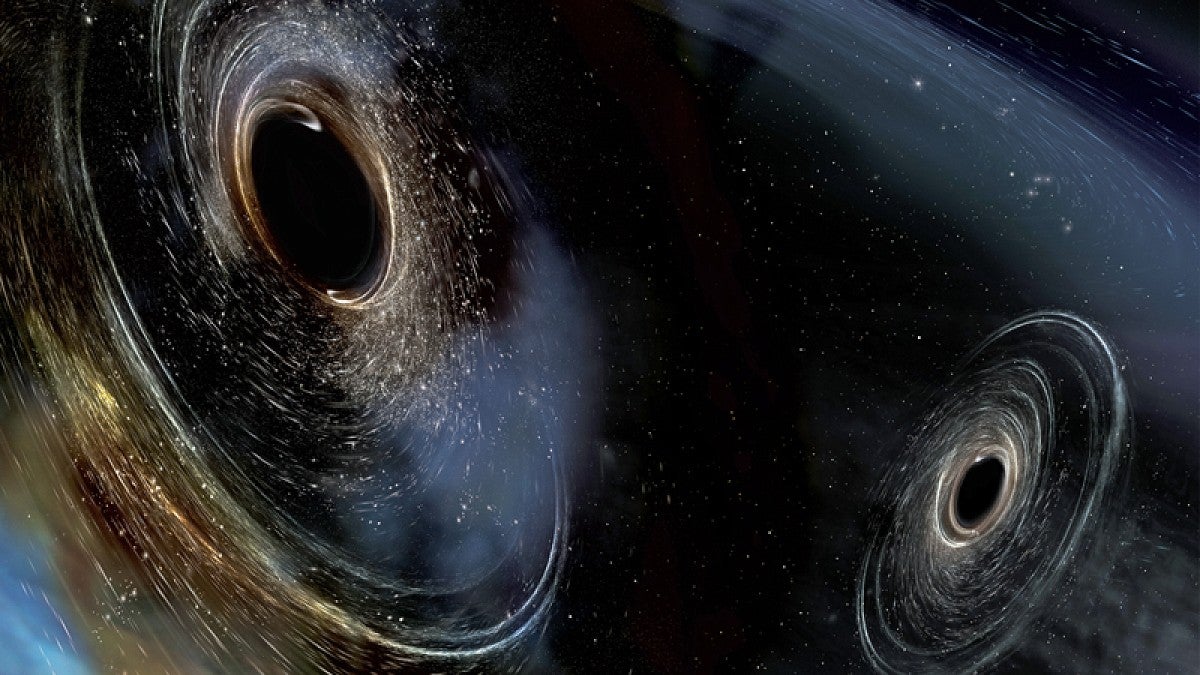Some 3 billion light years away in space, two black holes merged into one with a mass about 48 times that of the sun. It happened in the deep past but evidence for the event was detected Jan. 4 by an international team that includes several UO physicists.
Collaborating scientists of the Laser Interferometer Gravitational Wave Observatory — better known as LIGO — reported that they found gravitational waves generated by the merger in a paper placed online June 1 in the journal Physical Review Letters.
In February 2016, LIGO scientists announced the first-ever detection of gravitational waves, which are ripples in the curvature of spacetime caused by a disturbance. Albert Einstein predicted their presence in his general theory of relatively in 1915.
“Two solar masses worth of energy were released from the binary system in the form of gravitational waves,” said Raymond Frey, who heads the UO’s team in LIGO project, about the newly detected event. “In other words, it’s as though two suns completely vanished into gravitational wave energy. Through efforts like this we are learning new things about the universe.”
As in the previous discovery, the UO’s primary role involved behind-the-scenes screening efforts to fine tune LIGO’s detectors to make sure that signals of gravitational waves are not contaminated by background noises on Earth, such as lightning strikes, trucks on a highway, earthquakes and explosions. The UO’s role was vital in the initial discovery and detailed in the story “Confirming Einstein’s Theory.”
The interferometers used at the LIGO sites at Hanford, Washington and Livingston, Louisiana, consist of suspended mirrors, which reflect laser beams that are used to sense tiny mirror motions 1/10,000th the diameter of a proton caused by the passage of a gravitational wave.
Researchers named the newly detected gravitational waves as event GW170104. They came from a location twice as far from Earth as the waves spawned by the previous merger, GW150914. The new merger involved black holes with masses about 31 and 19 times the mass of the sun, the LIGO team reported.
Gravitational waves emitted from two other black-hole mergers were detected in LIGO’s first run. The first was recorded Sept. 14, 2015, but not confirmed and reported until extensive analyses ruled out other source possibilities in the data. The event captured in January is the first in LIGO’s second run, which began in late fall.
“The black holes now being discovered by LIGO are heavier than any stellar mass-scale black holes from research preceding the LIGO observations,” Frey said. “Their origin is of great scientific interest. The measured properties of the black holes, particularly their individual spin orientations, provide clues to their correct evolutionary paths.”
Three UO faculty members are co-authors on the new paper: Frey, head of the Department of Physics; Robert Schofield, a research professor who led environmental screening efforts; and James Brau. Other UO co-authors are postdoctoral researcher Dipongkar Talukder and graduate students Sudarshan Karki, Jordan Palamos, Ryan Quitzow-James, Vincent Roma and Paul Schale.
Another co-author Ben Farr, a postdoctoral researcher at the University of Chicago, will join the UO’s physics department in September and work on the LIGO team.
LIGO is operated by Caltech and MIT, which conceived and built the Observatory. The LIGO Scientific Collaboration includes more than 1,000 scientists from around the world participate and is primarily funded by the National Science Foundation and agencies in Germany, the United Kingdom and Australia.
—By Jim Barlow, University Communications


